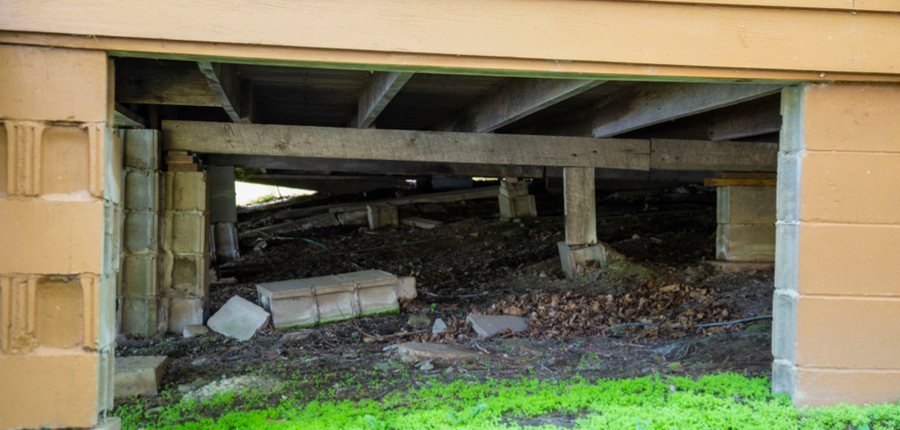Your home’s crawl space may not be as gorgeous as your living room but it sure does play a more important role. Crawl spaces act as your home’s central heating system. It controls heat transfer between your house and the surroundings, which subsequently affects your home’s indoor temperature.
To maximize its functionality, most homeowners turn to crawl space encapsulation. A crawl space encapsulation’s purpose is to insulate the crawl space to prevent heat loss and to keep moisture out. This method can inhibit mold growth, maintain indoor air quality, and decrease energy consumption. But first, how much does crawl space encapsulation cost?
[topad]
Average Cost of Crawl Space Encapsulation Cost
If you’re looking for overall costs, estimates for total cost to encapsulate crawl space starts at $2,000 and may reach up to $15,000.
Here’s a few examples for some factors involved in crawl space encapsulation:
- Size of House
While the average rate of crawl space encapsulation is determined by numerous cost factors, the size of your house affects it the most. Obviously, a larger house will have a higher square footage, resulting to a higher cost to encapsulate crawl space.
With regards to size, the quotes usually starts at $2,000 to $4,000 for small-sized crawl spaces. This becomes $5,000 to $7,000 for crawl spaces with more than a thousand square feet. Crawl spaces with at least 2,000 square feet can cost as much as $8,000 to $14,000.
[mob]
- Type of Insulation
Insulation is the aspect directly related to heat transfer. It maintains the overall temperature and air quality of your home. Insulation also prevents heat loss during winter and excess heat in the summer. A properly insulated crawl space keeps your home’s indoor air clean and decreases your energy cost.
The efficiency of crawl space insulation depends on the type of insulating material used. Currently, there are four main categories for insulation materials:
- Spray foam
This type of insulation material uses liquid polyurethane and sprays it into wall cavities. The foam will harden after a while, which in turn will seal the holes in the wall. When correctly installed, spray foam insulation can lead to energy savings of up to $500 per year.
[middletwo]
Additionally, there are two types of spray foam insulation:
-
- open-cell spray foam – $0.35 to $0.55 per board foot
- closed-cell spray foam – $1 to $2 per board foot
(One board foot measures 12 inches wide x 12 inches long x 1 inch thick.)
2. Blown-in cellulose
Made from cellulose which is a plant-based material used in papermaking, this insulation material is eco-friendly and water-resistant. Cellulose also contains borate, a type of preservative commonly found in wood. Borate is a fire-retardant and will also keep fungus, vermin, and insects from eating away at the insulation. Plus, blown-in cellulose is very easy to install – perfect for DIY.
[mob]
- material – $28 to $30 for a 19 lb. pack
- labor – $1.50 to $2 per square feet
3. Fiberglass batts
Composed of very fine glass fibers, fiberglass batts are the oldest type of insulation material. It is usually inserted between the joist bands of the crawl space. Fiberglass batts are inexpensive but they tend to break and fall out, and they also absorb moisture.
- material – $0.64 to $1.19 per square foot
- labor – $150 to $300 per hour
4. Rigid foam
Rigid foam is very similar to Styrofoam. It’s a stiff material yet you can cut through it and fit it into the crawl space. Rigid foam effectively prevents heat transfer
- material – $0.40 to $0.75 per square foot
- labor – $1.25 to $2.65 per square foot
[middletwo]
- Type of Vapor Barrier
A vapor barrier is the material used to cover the foundation, walls, and band joists to damp-proof a crawl space. Technically, vapor barriers do not really resist moisture; they just slow down the movement of moisture. In other words, moisture can still pass through a vapor barrier but only in very small amounts and at very slow rates.
More accurately called as “vapor diffusion retarders”, vapor barriers have different materials, permeability, and thickness. Here are some examples of cost estimates:
- vapor retarder paint – $20 to $40 per gallon
- polyethylene plastic sheet (single ply, 6 mil) – $0.05 to $.20 per square foot
- multiple ply, 8 to 23 mil – $0.25 to $1.50 per square foot
- labor cost – $0.65 to $2 per square foot
- Location
[mob]
Your home’s location also affects the average rate of crawl space encapsulation. If you live in a high-temperature area, you can expect to pay more for the vapor barrier and insulation material costs. This is due to the high humidity content in your region.
- Age of the House
If the house was built prior to the establishment of current building codes, chances are the final cost will be higher. To update an old property and make it comply with present codes, a major house makeover is necessary. Hence, an old crawl space requires more resources and labor compared to a crawl space from a newer home.

